As the Sakonnet River Race approached (and surely I’m not the first to wonder how exactly this long ocean bay qualifies as a “river”), I was excited to find that Wesley had decided on an alternate course that would take us from 3rd Beach (near the mouth of the river) to Island Park Beach (at the, uh, source of the river?) – 10+ miles of downwind. In the days leading up to race, I wore a groove in the NOAA web site by checking the marine forecast every 7 minutes. Would the winds swing far enough to the south to provide ideal downwind conditions? Could we avoid thunderstorms? How much rain were we going to get?
Things were looking good, at least with respect to the wind direction and velocity. Really good. And then they were looking *too* good. With waves forecast to hit 6+ feet at the mouth of the river, Wesley wisely made the call the eve of the race to switch the course to one very similar to that used 2 years ago. We’d start at McCorrie Point, go upwind (south) 1.7 miles, then head downwind 4.5 miles to Island Park Beach, and finally return upwind 3.0 miles to our starting point. Rumor has it that Wesley had also considered a flatwater course to be held in the newly formed lake in the dirt road leading to the beach, but the resident gators made that option too treacherous.
After tentatively navigating said road, I arrived on the beach to find a mixture of new, newish, and old faces (must be the salt air). From the unknown wilds beyond the bounds of New England, Flavio Costa, Jan Lupinski, Beata Cseke, Kam Truhn, Dave Furniss, and Bob Capellini joined the race. The Commonwealth delivered Mike Tracy, Chris Chappell, Chris Sherwood, Tucker Lindquist, and myself. Dave Grainger made the trek from Connecticut. Robin Francis and Gary Williams joined too, from parts unknown (sorry). Since they’re actually pictured on the Rhode Island state flag, Wesley and Tim Dwyer were naturally obligated to represent the Ocean State.
Wesley called in the troops to provide an overview of the revised course. I had some concerns about being able to locate the two turn-around points (I’m not sure that “just offshore from where the big red house used to be” and “you know, where they rescued that beached whale back in 94” qualify as reliable landmarks), but I have excellent instincts when it comes to mindlessly following the leader. As it turned out, the turn-arounds were roughly as obvious as Wesley indicated.
After a brief delay to allow the rain to slack off from deluge to downpour, we hopped in our boats. Given the conditions, I had opted for my Huki S1-R rather than my V12. During warm-ups, I knew I had made the right decision. I had dumped off my Epic twice a couple of days before the race while doing some little downwind runs in Ipswich Bay, so having my S1-R under me was a real relief in the blustery conditions. As we lined up facing into the wind and rain, Wesley counted us down to a moving start. Paddles started whirling, someone shouted “Once more into the breach, dear friends!” (in my head, at least), and we were off. Flavio took a quick lead. Wesley had warned us during the skippers’ meeting not to cut McCorrie Point too close due to the low tide shallows, so I deliberately stayed outside of him. Out of the corner of my eye, however, I caught a glimpse of Tim trying out Epic’s new sand rudder. Still needs some fine tuning, apparently.
After rounding the point, we settled into our individual cadences for the 1.7 mile upwind leg. Wesley and I paddled alongside one another for a while, after which Dave Furniss took his place in his Think Evo. Dave edged me out in the cross-beam chop at the finish of last year’s Lighthouse-to-Lighthouse race, and he put up in an impressive showing in flat water at the Essex River Race, so I have a healthy respect for his skills and fitness. When I arrived at the moored sailboat marking the first turn-around, Flavio was 7 or 8 boat length ahead of me, Dave a length or two behind me, and Wesley not far behind him. With the wind now howling at our backs, it was time to catch some rides.
Going into the race, my mantra for the downwind leg was “choose your battles”. Not every wave is worth catching. Wait for the right set before redlining to get the ride. About 30 seconds into the downwind leg, my new mantra was “Huff. Huff. Huff. Wheeee!!!” After 10 minutes exhausting myself trying to milk every wave, I managed to settle down and make slightly better decisions. The threat of an exploding heart will really make you rethink priorities.
After the turn, Wesley must have headed straight out for the middle of the bay, because the next time I saw him he was a sliver way off to my right. Flavio chose to take a line very close to the shore. I caught a single glimpse of Dave off to my left and slightly behind. Given that Wesley practically designed the Sakonnet River, I figured he would know the best line. So for the next 5 miles I struggled to pull right towards the center of the bay. With the prevailing wind from the southeast (that is, pushing me to the left), this put my intentions and my boat’s intentions somewhat at odds. After some bitter words and threats of legal action, we established a reluctant compromise – we’d make a run with the waves, then peel off to the right and take a few strokes to get back on line. Every once in a while, a rogue set of waves would be aligned with my preferred direction. Oh, those happy times.
As we approached Island Park Beach, I began to have hopes that I might reach the turn-around in the lead. Wesley still had a slightly better line, but he appeared to be back a ways. I assumed Dave was somewhere close, but behind me. Flavio seemed to be about equal with me, but he’d have to cut diagonally right from his line to get around the pair of boats that marked the turn-around. I tried to do some trigonometry in my head. I was maybe 250 meters from the turn-around on a direct line, Flavio was 50 meters to my left and perhaps traveling 2% faster. Let’s see, cosine, carry the 3, take the square root… The answer kept coming up “Uzbekistan”, so I must have been doing something wrong. I decided to let reality resolve the matter.
Flavio hit the turn-around maybe 10 boat lengths ahead of me (just as I had computed). I hadn’t really thought much about the turn-around itself until I noticed that I was no longer in my boat. Hmm. I had been caught by surprise by the steep waves in the shallower water, even before initiating the actual turn. Fortunately, I was able to clamber awkwardly back on from the downwind side of the boat. After navigating the turn-around itself, I discovered that somebody had dialed up the conditions a notch.
Although the first leg of the race had also been upwind, the wind had picked up significantly since then. The Sakonnet basin lay in front of me, whipped into orneriness by a scathing 20+ mph wind. My heart sank at the prospect of having to pull myself back up to McCorrie Point through this frothy mess. We were in for a slog. To make matters worse, Dave appeared at my side, having caught me just after the turn-around. I had seen Wesley making the turn not too long after I had, so I knew that he must be lurking somewhere close as well.
After a few moments, I noticed Dave dropping back just a little and then lost sight of him. Afterwards I found that he had stopped to grab a gel, apparently misinterpreting the “wash down with water” instruction in the process. Two remounts later, he had fallen a ways back. I was heartened to hear later that several other people besides me also practiced their emergency exit strategies during the race. In the unlikely event of a water landing… Chris Chappell claims that he deserves special mention for the number of times he diverged from vertical.
I couldn’t decide the best path to take back to McCorrie Point – would it be better to hug closer to the shore or to blast across straight towards the finish? I wasn’t convinced that there’d be significant protection from the southeast wind on the western shore, and I feared that the waves would get unmanageably steep in the shallower water. So I followed Flavio and tried the straight(ish) line approach. Most others tried the shore approach, with mixed reports (see comment on Chris above).
That final upwind leg would ultimately last less than 40 minutes, with a net physical effort that wasn’t out of line from what I’d expect in the closing leg of a race. That being said, it truly was a miserable, demoralizing slog. Sudden gusts would hammer you in the chest, bringing you to what seemed like a standstill. I could feel my boat flexing as it surged nose high over particularly big waves and slapped down in the troughs (a side effect of which was that, at some point during the drive home, my Huki divested itself of its rudder – the constant pounding must have loosened the restraining nut). I barley averaged 5 mph for the upwind leg – particularly disheartening after the preceding downwind Sakonnet sleigh ride. Ever so slowly, however, McCorrie Point edged closer until, finally, it was all over. For Flavio. Even though it had seemed like he wasn’t that far ahead of me, I still had a few more minutes of slogging to go.
Safely on land (where conditions seemed downright idyllic), it wasn’t long before Dave and Wesley hove into view. Tim, Beata, and Dave Grainger followed. All of the participants completed the challenging course, although Wrong Way Chappell somehow managed to finish from the opposite direction and Tucker spent half the race bailing out his leaky Surge. Although nobody actually kissed the ground, everybody seemed relieved to be back on land. Except perhaps for Flavio, who spent a solid minute after the race engaged in a spirited wrestling match with his leg leash in the shallows. Afterwards, Wesley and Betsy handed out our nifty shirts (visible from space!), got the damp crew together for a group photo, and announced the top places. Thanks to both for putting on another great race, despite frustrating changes in the weather. And congrats to all who raced – especially those who had only limited rough-water experience on skis. Hope to see everyone at the Blackburn in 6 weeks!
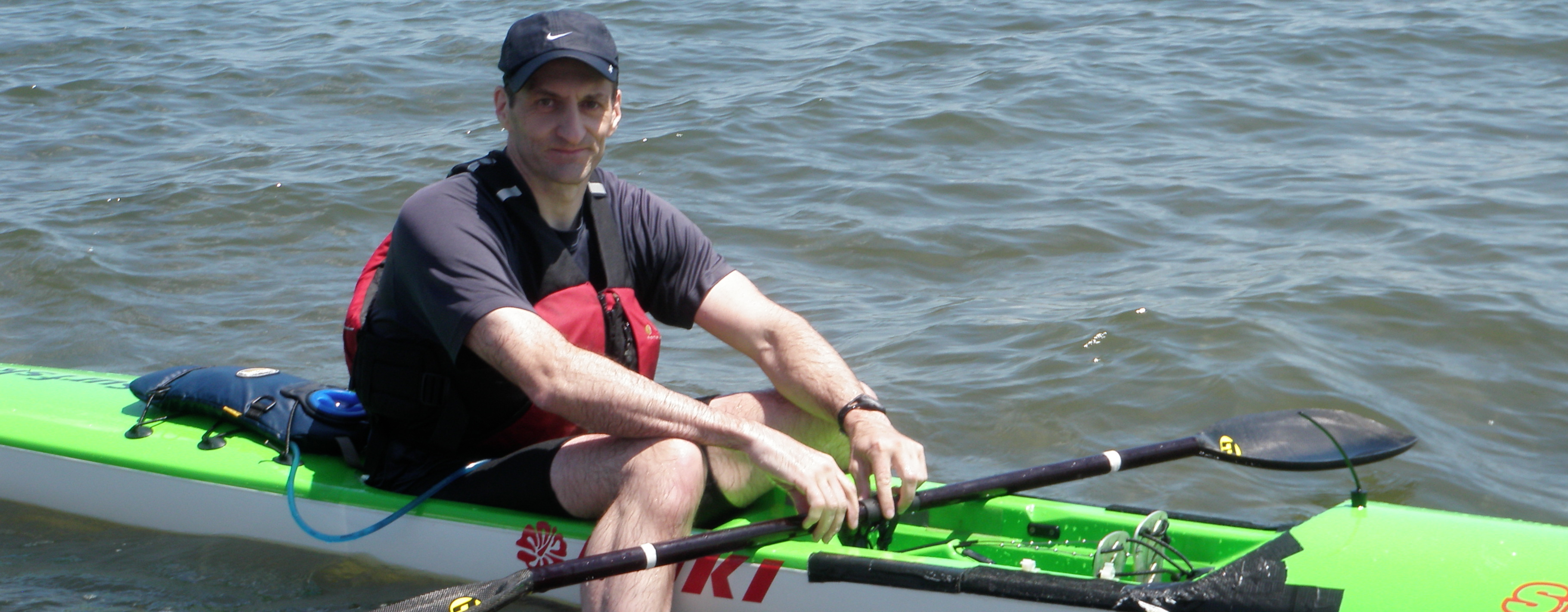
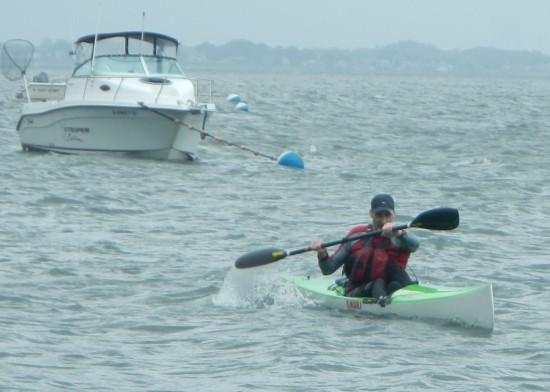
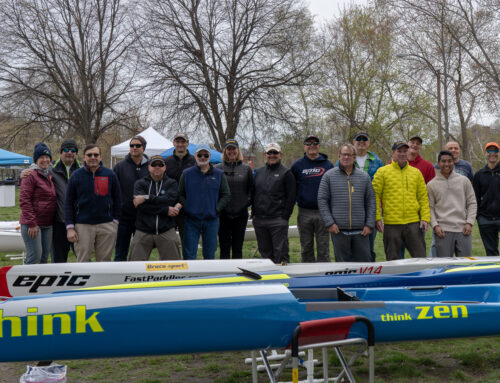
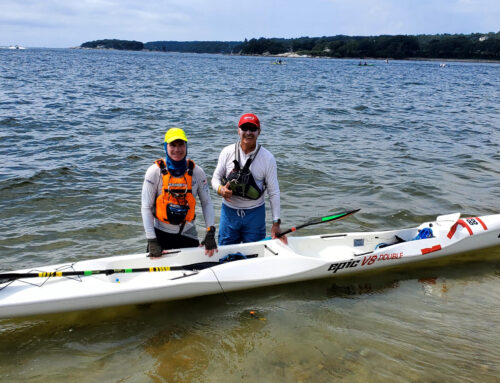
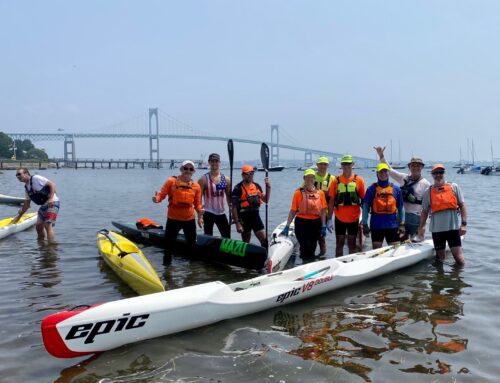
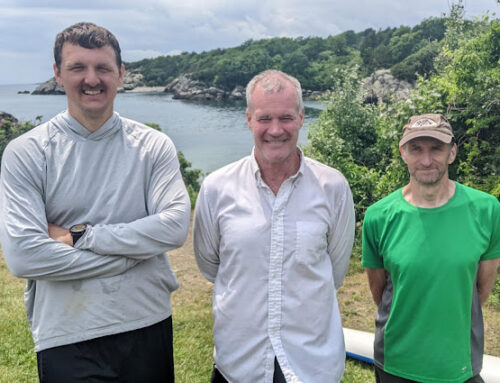
Leave A Comment
You must be logged in to post a comment.